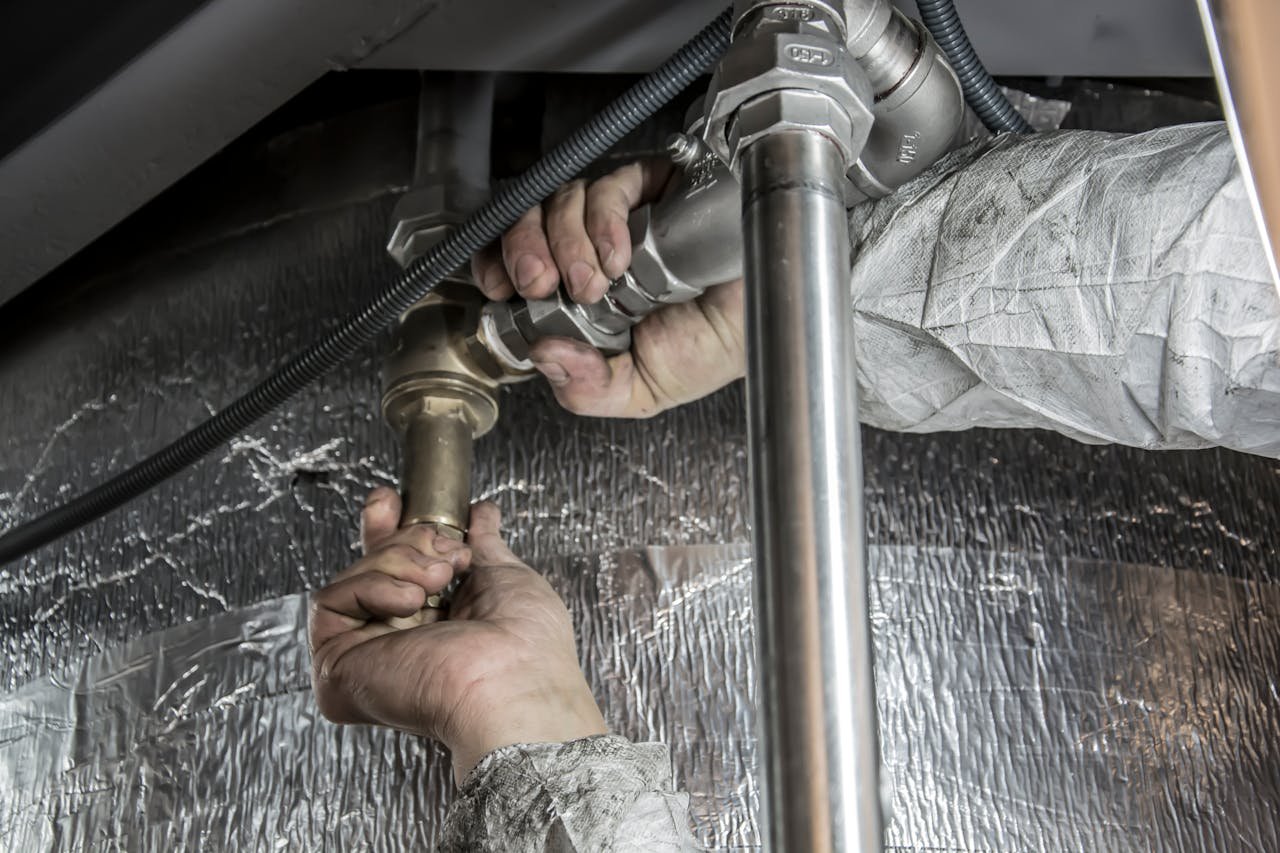Dealing with a leaky faucet can be more than just an annoyance; it can lead to water wastage, increased utility bills, and even water damage that requires extensive repairs. Fortunately, fixing a leaky faucet is often a straightforward task that can be tackled with a little DIY know-how. This article will guide you through understanding the causes of faucet leaks, providing step-by-step repair instructions, and offering tips on when to call a professional, as well as how to maintain your faucets to prevent future leaks.
Table of Contents
ToggleKey Takeaways
- Identify the cause of the leak, such as worn washers or O-rings, and understand the impact of ignoring a leaky faucet, including water wastage and potential damage.
- Gather the necessary tools and materials before attempting a repair, and follow the provided step-by-step instructions to fix common types of faucet leaks.
- Know when to call a professional plumber, especially if the leak persists after a DIY fix or if the faucet issue is complex and beyond your skill level.
- Implement preventive measures, such as regular inspections and replacing worn components, to extend the life of your faucets and avoid future leaks.
- Consider upgrading to a modern faucet with new features and technologies for better performance and water efficiency, and follow installation tips for a successful upgrade.
Understanding Faucet Leaks
Common Causes of Leaky Faucets
Leaky faucets are a common household nuisance, often leading to water wastage and increased utility bills. The primary culprit behind these leaks is typically a worn-out washer or O-ring. Over time, these components can deteriorate due to constant use and water pressure, resulting in a faucet that drips or leaks at the base.
Other factors contributing to faucet leaks include:
- Corroded valve seats
- Worn out seals
- Improper installation of faucet parts
- Loose parts due to vibrations or use
- Mineral deposits on internal parts
While some leaks are straightforward to fix, others may indicate more serious plumbing issues. It’s essential to address leaks promptly to prevent further damage and costly repairs.
If you’re experiencing inconsistent water flow or leaks that persist after simple repairs, it may be time to consult a professional. Remember, a small leak can lead to significant water loss over time, so early intervention is key.
The Impact of a Leaky Faucet
A leaky faucet might seem like a minor inconvenience, but its effects can be surprisingly far-reaching. Water wastage is a primary concern, as even a slow drip can add up to a significant amount over time. This not only impacts the environment but also inflates your water bill, making it an unnecessary expense.
Beyond the immediate financial cost, there are potential long-term consequences. Persistent moisture from leaks can lead to the growth of mold and mildew, especially in areas like bathrooms. This can create an unhealthy living environment and may require costly remediation efforts.
The continuous drip of a leaky faucet is more than just a nuisance; it’s a sign of water and money trickling away.
Addressing a leak promptly can prevent these issues, ensuring your home remains safe and cost-effective. If you’ve noticed an unexplained increase in your water bill, it could be a sign that it’s time to inspect your faucets for leaks.
Identifying the Source of the Leak
To effectively address a leaky faucet, it’s crucial to first identify where the leak is coming from. Perform a visual inspection to check for any obvious signs of leakage. If the source isn’t immediately apparent, you can use a simple test: shut off the water supply valves, dry the faucet area, wrap it with toilet paper, and turn the valves back on. The wet spot on the paper will indicate the leak’s location.
Once the leak’s origin is determined, you can proceed to fix the specific problem, such as a damaged “O” ring or a faulty washer.
Leaks can lead to significant property damage if not addressed promptly. A visual-tactile inspection can help you feel for moisture and locate the leak. Remember, finding water under the sink doesn’t always pinpoint the leak’s source, as water can travel along pipes.
Here are some common leak locations and their potential causes:
- Spout: Worn-out seals or O-rings
- Handles: Damaged gaskets or packing nuts
- Base of the faucet: Corroded valve seat or worn-out washers
Identifying the leak is the first step towards a lasting repair. Once you know where the problem lies, you can gather the right tools and materials to fix it.
DIY Faucet Repair Guide
Tools and Materials You’ll Need
Before you begin the repair, it’s essential to gather all the necessary tools and materials. Having the right equipment at hand will make the process smoother and more efficient.
Here’s what you’ll need:
- Towels or rags to keep the work area dry
- A Phillips-head screwdriver
- A flat-head screwdriver
- Needle-nose pliers for small or hard-to-reach areas
- Standard pliers
- A pipe wrench, which is crucial for gripping and turning pipes
- An adjustable wrench for various nut and bolt sizes
- Teflon tape to ensure a watertight seal on threaded joints
Ensure you have all items ready before you start, as interruptions to fetch tools can complicate the repair process.
While some items like screwdrivers and pliers are common in most households, others such as a pipe wrench or Teflon tape may need to be purchased or borrowed. Refer to a comprehensive list like the one from ServiceTitan titled “32 Best Plumbing Tools: A List of Essentials in 2024” for additional guidance.
Step-by-Step Instructions
After gathering your tools and shutting off the water supply, you’re ready to begin the repair process. Start by disassembling the faucet handle to access the internal components. This usually involves removing a screw or cap at the base or top of the handle.
Next, inspect the O-ring and washer inside the valve seat. These are often the culprits behind a leak. If they appear worn or damaged, replace them with new ones from your repair kit. Ensure the replacements match the size and shape of the originals.
With the new components in place, reassemble the faucet handle and turn the water supply back on. Check for leaks and ensure smooth operation. If the faucet still drips, the issue may lie deeper within the plumbing.
Finally, clean any debris from the aerator by unscrewing it from the faucet’s end and rinsing it under water. A clogged aerator can cause irregular water flow, mimicking a leak.
Troubleshooting Persistent Leaks
Even after following the step-by-step instructions, some leaks may persist. This often indicates a deeper issue that requires a more thorough investigation. Start by re-examining all the components you’ve worked on. Ensure that everything is properly tightened and that no parts are damaged or worn out beyond repair.
If the problem continues, consider the possibility of a compromised water supply line or a fault in the faucet’s internal mechanism. In such cases, it might be necessary to disassemble the faucet again and inspect each part more closely. Pay special attention to the seats and springs, as these are common culprits in persistent leaks. If the faucet drips from the end of the spout, replace the seats and springs.
Sometimes, the issue may not be with the faucet itself but with the plumbing. Check for signs of corrosion or damage in the pipes that could be contributing to the leak.
Below is a list of potential issues to look for when troubleshooting persistent leaks:
- Worn out O-rings or washers
- Corroded valve seats
- Improperly installed components
- Cracks in the faucet body
- Faulty gaskets or seals
If after all these steps the leak still remains, it may be time to consult a professional plumber.
When to Call a Professional
Complex Faucet Issues
While many faucet leaks can be resolved with DIY methods, certain complex issues require professional attention. Complex faucet problems may involve internal valve damage, corrosion, or incompatibility with replacement parts, which are not always apparent to the untrained eye. These issues can escalate if not addressed properly, leading to more significant damage and costs.
- Internal valve damage
- Advanced corrosion
- Incompatibility with standard replacement parts
- Integration with home automation systems
In cases where the faucet is integrated with home automation systems or has specialized components, the complexity of repairs increases. A professional plumber will have the necessary expertise to diagnose and resolve these intricate problems without causing further damage to your plumbing system.
It’s essential to recognize when a problem is beyond a simple fix. If you’re facing persistent leaks despite replacing washers and gaskets, or if you notice extensive corrosion, it’s time to consult a professional. They can provide a thorough assessment and a long-term solution that ensures the durability and functionality of your faucet.
Benefits of Professional Repair Services
Opting for professional repair services ensures that your faucet issues are handled with expertise. Plumbers have the necessary tools and experience to diagnose and fix leaks that might be beyond the reach of DIY methods. Professional intervention can prevent further damage that could occur from inexperienced attempts at repair.
The range of services offered by professionals is extensive, covering everything from simple leaks to complex plumbing systems. Here’s a list of some common services:
- Leaking Kitchen Faucet Repair
- Leaking Shower Repair
- Leaking Toilet Repair
- Leaking Water Heater Repair
Guaranteed Results: Most professional plumbers offer a guarantee on their work, giving you peace of mind knowing that if the leak persists, they will return to address the issue at no extra cost.
By entrusting your faucet repair to a professional, you also benefit from their knowledge of the latest industry standards and technologies, which can lead to more efficient and long-lasting solutions.
How to Choose the Right Plumber
Selecting the right plumber is crucial for ensuring that your plumbing issues are resolved efficiently and effectively. Look for licensed professionals with a proven track record of success. It’s important to consider their experience, customer reviews, and the range of services they offer.
When reaching out to potential plumbers, be clear about your problem and ask for an estimate. A reliable plumber should be transparent about their pricing and willing to provide a detailed quote. Here’s a simple checklist to help you in your selection process:
- Verify the plumber’s license and insurance
- Check for customer testimonials and reviews
- Inquire about their experience with your specific issue
- Ask for a detailed estimate
- Ensure they offer a warranty or guarantee on their work
A good plumber not only fixes the current issue but also helps prevent future problems. They should be able to offer advice on maintenance and care for your plumbing system.
Remember, the recommendation of a client is always the best marketing for any business. Don’t hesitate to ask family and friends for referrals. Their firsthand experiences can provide valuable insights into the plumber’s reliability and quality of work.
Preventive Measures and Maintenance
Regular Inspection and Cleaning
Conducting regular inspections and cleaning of your faucet can prevent many common issues and extend its lifespan. Check for leaks or drips from the faucet regularly and address them promptly to avoid water waste and potential damage.
For hard-to-remove deposits, a vinegar solution or a commercial faucet cleaner can be effective. It’s important to clean aerators and replace any worn washers or O-rings to maintain a proper seal.
By keeping your faucet clean and in good repair, you can ensure its efficient and reliable operation for years to come.
Replacing Worn Components
Over time, the components within your faucet will inevitably wear out, leading to leaks and inefficiency. Replacing these components is a crucial step in maintaining your faucet’s performance. Start by inspecting the O-rings and cartridge, as these are common culprits for leaks. If you notice any damage or wear, it’s time for a replacement.
When replacing parts, it’s essential to choose components that match the original ones in size and configuration. This ensures a proper fit and function. For instance, don’t attempt to replace a one-handle system with a two-handle one without confirming compatibility.
Here’s a quick rundown of the replacement process:
- Check and replace O-rings as needed to prevent leaks.
- Remove the old cartridge and insert a new one, securing it with a retaining clip.
- If your faucet uses a washerless cartridge, consider replacing the springs and washers along with the cartridge for a better seal.
- Ensure new handles and stems are identical to the old ones before installation.
- Install the new stem by turning it clockwise and tighten with a socket wrench.
- Attach the new handle, ensuring it fits snugly against the wall.
Tips for Long-Term Faucet Care
To ensure the longevity of your faucet, incorporate daily wiping into your routine. This simple act can prevent buildup and maintain the faucet’s appearance. Additionally, it’s crucial to deep clean your faucet on a regular basis; this not only preserves its shine but also allows you to spot any potential issues early on.
Regular inspection of your faucet’s internal components is key. Seals and gaskets can wear out over time, so replacing them as needed can prevent leaks before they start. It’s also wise to be aware of the lifespan of your faucet. A well-maintained faucet can last up to 15 years, but this can vary based on usage and local water conditions.
While DIY maintenance can be effective, there comes a time when a faucet may need to be replaced. Consider this option if you’re facing persistent issues or if your faucet is reaching the end of its expected lifespan.
Lastly, be proactive in addressing minor issues. Tackling problems like drips and low water flow can save you from more significant repairs down the line. By following these tips and considering replacement when necessary, you can maintain a functional and aesthetically pleasing bathroom space.
Upgrading Your Faucet
Choosing a New Faucet
When it’s time to upgrade your faucet, the selection process can be both exciting and overwhelming. Consider the faucet’s quality, finish, and style to ensure it complements your kitchen’s aesthetic and meets your functional needs. Different types of faucets, such as pull-down or wall-mounted options, offer unique features and can impact the installation process.
Here’s a quick guide to help you navigate the choices:
- Quality: Opt for faucets with an all-brass body for durability.
- Finish: Choose a finish that matches your kitchen’s hardware and is easy to clean.
- Style: Look for a style that fits your kitchen’s theme, be it modern or traditional.
- Type: Decide between single-handle, pull-down, pull-out, or other types of kitchen faucets.
- Handles: Single or multiple handles can affect both look and functionality.
- Mounting Holes: Ensure the faucet fits your sink’s mounting hole configuration.
Before making a purchase, take the spout with you to compare with the new one, ensuring a proper fit with your plumbing.
Remember, a new faucet not only refreshes the look of your kitchen but also can bring new functionalities and ease of use. Take your time to find the perfect match for your home.
Installation Tips for New Faucets
Installing a new faucet can be a straightforward process with the right preparation and steps. Ensure that your replacement faucet matches the original fittings to avoid complications during installation. Begin by removing any old caulk with a putty knife where the spout or handles meet the wall. If your new faucet is a threaded spout, apply fresh plumber’s tape over the threading of the wall pipe before securing the spout in place.
When installing single-handle tub faucets, insert the new tub faucet cartridge into the wall plumbing, ensuring it seats properly. Use the retaining clips to secure the cartridge, and then mount the escutcheon plate to the wall, aligning it correctly with the sleeve.
For a slip-on spout, slide it onto the pipe until it meets the wall, and secure it with a set screw. Apply bathroom sealant where the base of the spout meets the wall to prevent water leakage.
After all new fittings are in place, turn the water supply back on and test the faucet for any leaks. Use towels and sheets to protect the area from potential water damage during the process. Tools like screwdrivers, pliers, and wrenches will be essential, so have them ready before you start.
Modern Faucet Features and Technologies
The evolution of faucet design has led to a plethora of modern features and technologies that enhance both style and functionality. From touchless operation to smart home integration, the options available can transform a simple faucet into a centerpiece of convenience and efficiency.
- Touchless operation: hands-free convenience
- Smart home compatibility: control via voice or apps
- LED temperature indicators: visual cues for water temperature
- Water-saving technologies: including aerators and flow restrictors
Upgrading to a modern faucet not only adds aesthetic appeal but also contributes to water conservation and ease of use. These advancements reflect a commitment to eco-friendly options and user-centric design.
When selecting a new faucet, consider the Functionality Features for Convenience and Efficiency. Look for models that offer temperature control and water-saving technologies, such as aerators and flow restrictors, to ensure your kitchen remains both functional and environmentally conscious.
Conclusion
In conclusion, fixing a leaky faucet is not only a practical skill that can save you from the annoyance of a constant drip but also a financially and environmentally responsible action. By addressing the issue promptly, you can prevent water wastage, reduce your utility bills, and avoid potential water damage that could lead to more costly repairs. Whether you choose to tackle the repair yourself with the guidance provided in this article or opt to call in a professional plumber, taking action is essential. Remember, a small leak left unattended can lead to bigger problems, so don’t hesitate to fix that drip and ensure your faucets are functioning efficiently.
Read More: How To Cure Gum Disease Without A Dentist










